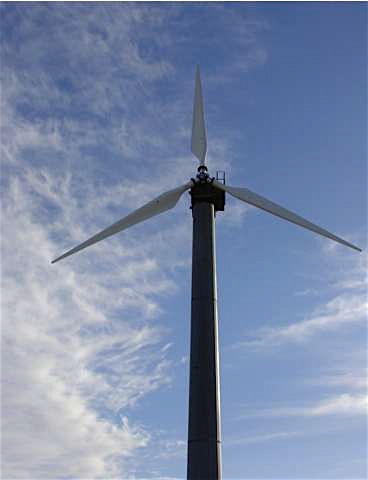New turbine blade opens up more of America to wind-power
A new wind turbine blade design that researchers
at Sandia National Laboratories developed in partnership with Knight &
Carver of San Diego promises to be more efficient than current designs. It
should significantly reduce the cost-of-energy of wind turbines at
low-wind-speed sites.

A new wind turbine blade design that researchers at
Sandia National Laboratories developed in partnership with Knight & Carver
of San Diego promises to be more efficient than current designs. It should
significantly reduce the cost-of-energy of wind turbines at
low-wind-speed sites.
Named “STAR” for Sweep Twist Adaptive Rotor, the blade is the first of its kind produced at a utility-grade size. Its most distinctive characteristic is a gently curved tip, termed “sweep,” which unlike the vast majority of blades in current use, is specially designed for low-wind-speed regions like the Midwest. The sites targeted by this effort have annual average wind speeds of 5.8 meters per second, measured at 10-meter height. Such sites are abundant in the U.S. and would increase by 20-fold the available land area that can be economically developed for wind energy.
The continued increase in the average size of utility-grade wind turbines may come to an end before all efficiencies are wrung out unless blade weight growth (which is nonlinear) can be reined in. The challenge is to develop new concepts that reduce the rate of weight growth, such as the swept STAR blade.
These new big-slow-blade designs are not only more efficient, especially at low speeds - they rotate slowly enough to remove the likelihood of danger to birds.
Named “STAR” for Sweep Twist Adaptive Rotor, the blade is the first of its kind produced at a utility-grade size. Its most distinctive characteristic is a gently curved tip, termed “sweep,” which unlike the vast majority of blades in current use, is specially designed for low-wind-speed regions like the Midwest. The sites targeted by this effort have annual average wind speeds of 5.8 meters per second, measured at 10-meter height. Such sites are abundant in the U.S. and would increase by 20-fold the available land area that can be economically developed for wind energy.
The continued increase in the average size of utility-grade wind turbines may come to an end before all efficiencies are wrung out unless blade weight growth (which is nonlinear) can be reined in. The challenge is to develop new concepts that reduce the rate of weight growth, such as the swept STAR blade.
These new big-slow-blade designs are not only more efficient, especially at low speeds - they rotate slowly enough to remove the likelihood of danger to birds.
Posted: Tue - March 20, 2007 at 09:11 AM